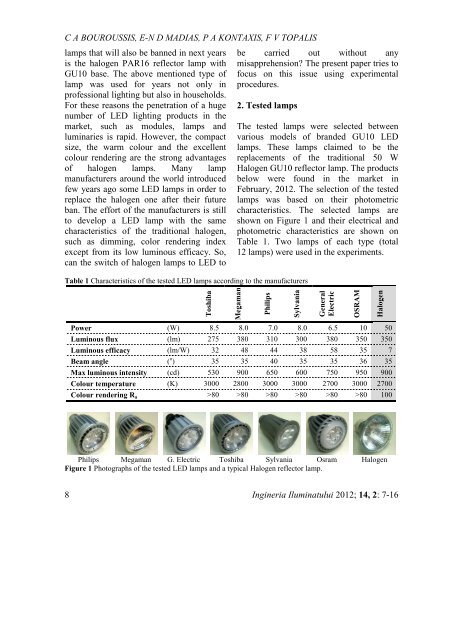Untitled - Journal of Lighting Engineering
Untitled - Journal of Lighting Engineering
Untitled - Journal of Lighting Engineering
You also want an ePaper? Increase the reach of your titles
YUMPU automatically turns print PDFs into web optimized ePapers that Google loves.
C A BOUROUSSIS, E-N D MADIAS, P A KONTAXIS, F V TOPALIS<br />
lamps that will also be banned in next years<br />
is the halogen PAR16 reflector lamp with<br />
GU10 base. The above mentioned type <strong>of</strong><br />
lamp was used for years not only in<br />
pr<strong>of</strong>essional lighting but also in households.<br />
For these reasons the penetration <strong>of</strong> a huge<br />
number <strong>of</strong> LED lighting products in the<br />
market, such as modules, lamps and<br />
luminaries is rapid. However, the compact<br />
size, the warm colour and the excellent<br />
colour rendering are the strong advantages<br />
<strong>of</strong> halogen lamps. Many lamp<br />
manufacturers around the world introduced<br />
few years ago some LED lamps in order to<br />
replace the halogen one after their future<br />
ban. The effort <strong>of</strong> the manufacturers is still<br />
to develop a LED lamp with the same<br />
characteristics <strong>of</strong> the traditional halogen,<br />
such as dimming, color rendering index<br />
except from its low luminous efficacy. So,<br />
can the switch <strong>of</strong> halogen lamps to LED to<br />
8<br />
be carried out without any<br />
misapprehension? The present paper tries to<br />
focus on this issue using experimental<br />
procedures.<br />
2. Tested lamps<br />
Table 1 Characteristics <strong>of</strong> the tested LED lamps according to the manufacturers<br />
Toshiba<br />
The tested lamps were selected between<br />
various models <strong>of</strong> branded GU10 LED<br />
lamps. These lamps claimed to be the<br />
replacements <strong>of</strong> the traditional 50 W<br />
Halogen GU10 reflector lamp. The products<br />
below were found in the market in<br />
February, 2012. The selection <strong>of</strong> the tested<br />
lamps was based on their photometric<br />
characteristics. The selected lamps are<br />
shown on Figure 1 and their electrical and<br />
photometric characteristics are shown on<br />
Table 1. Two lamps <strong>of</strong> each type (total<br />
12 lamps) were used in the experiments.<br />
Megaman<br />
Philips<br />
Sylvania<br />
General<br />
Electric<br />
Power (W) 8.5 8.0 7.0 8.0 6.5 10 50<br />
Luminous flux (lm) 275 380 310 300 380 350 350<br />
Luminous efficacy (lm/W) 32 48 44 38 58 35 7<br />
Beam angle ( o ) 35 35 40 35 35 36 35<br />
Max luminous intensity (cd) 530 900 650 600 750 950 900<br />
Colour temperature (K) 3000 2800 3000 3000 2700 3000 2700<br />
Colour rendering Ra >80 >80 >80 >80 >80 >80 100<br />
Philips Megaman G. Electric Toshiba Sylvania Osram<br />
Figure 1 Photographs <strong>of</strong> the tested LED lamps and a typical Halogen reflector lamp.<br />
OSRAM<br />
Halogen<br />
Halogen<br />
Ingineria Iluminatului 2012; 14, 2: 7-16
















